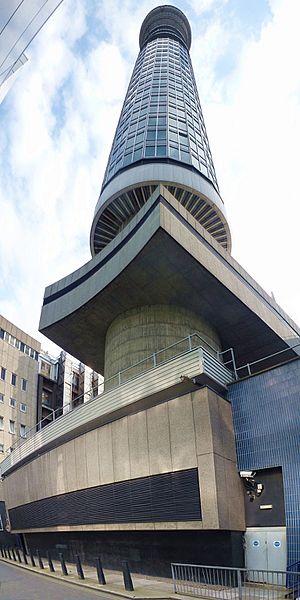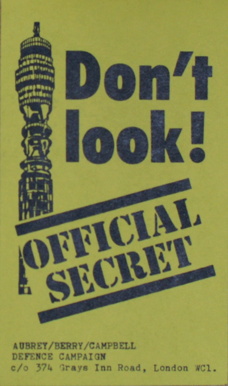BT Tower facts for kids
Quick facts for kids BT Tower |
|
|---|---|
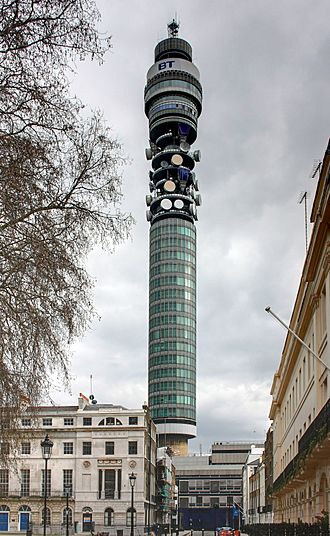 |
|
| Record height | |
| Tallest in the United Kingdom from 1964 to 1980 | |
| Preceded by | Millbank Tower |
| Surpassed by | Tower 42 |
| General information | |
| Type | Offices |
| Location | London, W1T United Kingdom |
| Coordinates | 51°31′17″N 0°08′20″W / 51.5215°N 0.1389°W |
| Construction started | 1961 |
| Completed | 1964 |
| Height | |
| Antenna spire | 189.0 metres (620.1 ft) |
| Roof | 177.0 metres (580.7 ft) |
| Technical details | |
| Floor count | 37 |
| Lifts/elevators | 2 |
| Design and construction | |
| Architect | Eric Bedford |
| Main contractor | Peter Lind & Company |
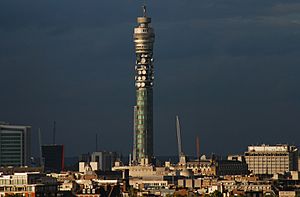
The BT Tower is a tall building in Fitzrovia, London. It is used for sending and receiving communications signals. The company BT Group owns it. In the past, it was known by other names like the Post Office Tower. The main part of the tower is about 177 meters (581 feet) high. With its antennas, it reaches a total height of 189 meters (620 feet).
When it was finished in 1964, the BT Tower became the tallest building in London and the whole United Kingdom. It held this record until 1980. Then, a building called Tower 42 became taller.
Contents
The Tower's History
Building the BT Tower
The tower was built by the General Post Office (GPO). Its main job was to hold microwave antennas. These antennas helped send phone calls and other messages across the country from London. Before this tower, there was a smaller steel tower. It was used to send TV signals between London and Birmingham.
The new, taller tower was needed to make sure signals could travel without being blocked. Many tall buildings were being planned in London. The tower's signals went to other GPO stations. These included places like Harrow Weald and Bagshot. They also connected to important places like the London Air Traffic Control Centre.
The architects from the Ministry of Public Building and Works designed the tower. Eric Bedford was one of the main architects. The building is made of concrete covered with glass. Its round shape was chosen to help the antennas work best. The tower moves very little, only about 25 centimeters (10 inches), even in strong winds. The first 16 floors were for technical equipment. Above that, there was a section for microwave antennas. Higher up were floors for offices, kitchens, and a restaurant that spun around. The glass was specially tinted to stop too much heat from building up. Building the tower cost about £2.5 million.
Construction started in June 1961. Because it was so tall, the tower quickly became a famous landmark in London. People could see it from almost anywhere. The tower was finished on July 15, 1964. The Prime Minister, Harold Wilson, officially opened it on October 8, 1965.
Opening and Early Use
The BT Tower officially opened to the public on May 19, 1966. Tony Benn, a government minister, and Billy Butlin, who ran holiday camps, were there. Even Queen Elizabeth II visited the tower before it opened to everyone.
Besides the communication equipment, the tower had viewing areas. There was also a gift shop and a spinning restaurant on the 34th floor. This restaurant was called The Top of the Tower. It was run by Butlins. The restaurant slowly turned, completing one full circle every 23 minutes. In its first year, almost a million people visited the tower. Over 100,000 people ate in the restaurant.
Changes and Closure
On October 31, 1971, there was an incident at the tower. A bomb exploded in the men's toilets of the restaurant. After this event, the tower was mostly closed to the public for safety reasons. The restaurant closed to visitors a few months later. Public access to the building stopped completely in 1981.
Even though it is closed to the public, the tower still has its revolving floor. It is sometimes used for special events. For example, it hosts a children's Christmas party in December. It also helps with charity events like Children in Need. The revolving floor offers amazing views of London.
Tower Races
People have even raced up the tower's stairs! The first recorded race was on April 18, 1968. Students from University College London and Edinburgh University competed. An Edinburgh runner won in 4 minutes and 46 seconds. In 1969, eight university teams raced. A student from Manchester University won that year.
Keeping it a Secret?
Because the tower was so important for the country's communication, information about it was once considered a secret. In 1978, a journalist named Duncan Campbell was on trial. He was accused of collecting information about secret places. During the trial, the judge said that the tower could not be named. It was only called 'Location 23'.
Many people believe the tower did not appear on maps. This is not true. Even though it was 177 meters tall and open to the public for many years, it was on maps. For example, it was shown on Ordnance Survey maps from 1971 and 1981. It also appeared in the London A–Z street atlas from 1984.
In 1993, a politician named Kate Hoey joked about how silly it was to keep such a famous building a secret. She said she hoped she was allowed to confirm that the tower existed and say where it was.
The Tower Today
The BT Tower is still very much in use today. It is a major hub for communications in the UK. Most communication now uses fiber optic cables buried underground. However, the tower's old microwave links are still used for some purposes. The second floor of the tower's base has the TV Network Switching Centre. This center handles TV broadcasts. It sends signals between TV companies, production teams, and satellite services.
In the early 2000s, the top of the tower got a new lighting system. It shows a 360-degree display of seven changing colors at night. This makes the tower look like a spinning globe. It represents BT's idea of a "connected world." In 2009, an even better LED display was added. This "Information Band" wraps around the 36th and 37th floors. It is about 167 meters (548 feet) up. It has over half a million tiny LED lights! This display is the biggest of its kind in the world. It covers an area of 280 square meters (3,000 sq ft). The display turns off at 10:30 PM every night. In 2009, it started showing a countdown to the London Olympics in 2012.
There were talks about reopening the revolving restaurant for the 2012 Olympics. However, these plans were later canceled. For the tower's 50th birthday in 2015, the 34th floor was opened for three days. About 2,400 lucky people who won a lottery got to visit.
The BT Tower was given a special "Grade II listed building" status in 2003. This means it is a historically important building. Because of this, some old antennas could not be removed without special permission. In 2011, permission was given to remove them because they were old and unsafe. By December 2011, all the old antennas were gone.
Two fast lifts take visitors to the top of the tower. They travel at about 7 meters per second (16 mph). This means they reach the top in less than 30 seconds! A special law was passed to allow people to use the lifts to leave the building in an emergency. This was unusual for buildings at that time.
Since 2006, the tower has also been used to study air quality. It helps scientists measure pollution levels high above the ground. This helps them understand where pollution comes from in London.
The BT Tower in Stories
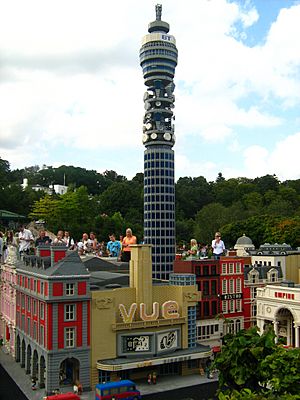
The BT Tower has appeared in many films, books, and TV shows:
- In the film Three Hats for Lisa (1965), characters hide in the tower while it is being built.
- The film Smashing Time (1967) shows the tower spinning out of control. This causes power cuts all over London.
- In the film Bedazzled (1967), the character playing Satan uses the tower to cause trouble.
- The tower is mentioned often in Iris Murdoch's novel The Black Prince (1973). The restaurant is even a setting for a lunch scene.
- In the novel The Fog (1975) by James Herbert, a large plane crashes into and destroys the tower.
- The detective Spenser eats in the tower's restaurant in The Judas Goat (1978).
- An alien robot destroys the tower in an episode of Danger Mouse (1981).
- In Alan Moore's graphic novel V for Vendetta (1982), the tower is the headquarters for government spying. It is later destroyed. In the film (2005), it is called Jordan Tower and is a TV network headquarters.
- The film London (1992) jokingly says the tower is a monument to a love story.
- The bombing incident is a key part of Hari Kunzru's novel My Revolutions (2007).
- In Daniel H. Wilson's novel Robopocalypse (2011), a smart robot uses the tower to control satellite communications.
- The tower is seen with fungi growing around it in the film The Girl with All the Gifts (2016).
- In the video game Watch Dogs: Legion (2020), a fictional company called Blume operates the tower.
Images for kids
-
View of the British Museum and the Thames from the BT Tower, 1966
See also
 In Spanish: BT Tower para niños
In Spanish: BT Tower para niños


